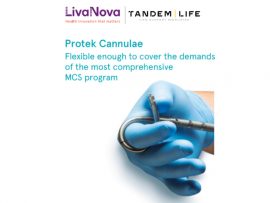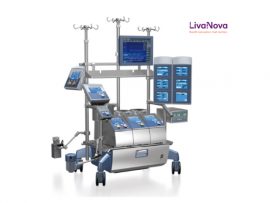Abstract Background Primary malignant cardiac tumors are rare in clinic, and surgical resection under cardiopulmonary bypass (CPB) remains the main treatment. The non-physiological perfusion process of CPB leads to contact activation,..
Read MoreAbstract Background Organizational factors may influence surgical outcomes, regardless of extensively studied factors such as patient preoperative risk and surgical complexity. This study was designed to explore how operating room..
Read MoreAbstract The physiologic impact of pulsatile flow (PF) on end-organ perfusion during cardiopulmonary bypass (CPB) is controversial. Using an intra-aortic balloon pump (IABP) to maintain PF during CPB for patients..
Read MoreAbstract The use of checklists in surgery is a best practice. There is a plethora of evidence that suggests using the WHO Surgical Safety Checklist (SSC) reduces complications such as pneumonia, intraoperative..
Read MoreAbstract Physiological hemostasis is a balance between pro- and anticoagulant pathways, and in sepsis, this equilibrium is disturbed, resulting in systemic thrombin generation, impaired anticoagulant activity, and suppression of fibrinolysis,..
Read MoreAbstract OBJECTIVES: Cardiac surgery-associated acute kidney injury (CS-AKI) is associated with adverse outcomes. Single-center studies suggest that the prevalence of CS-AKI is high after the Norwood procedure, or stage 1..
Read MoreAbstract In patients on veno-arterial extracorporeal membrane oxygenation (ECMO) premembranous venous oxygen saturation (Spm-vO2) is continuously displayed on the ECMO console. However, the concordance between Spm-vO2 and mixed venous oxygen saturation..
Read MoreAbstract Aim Venoarterial extracorporeal membrane oxygenation (VA-ECMO) has become a common intervention for patients with cardiogenic shock (CS), often complicated by cardiac arrest (CA). Moderate hypothermia (MH) has shown promise..
Read MoreAbstract Introduction A radical paradigm shift in the treatment of premature infants failing conventional treatment is to recreate fetal physiology using an extracorporeal Artificial Placenta (AP). The aim of this..
Read MoreAbstract This chapter provides an in-depth analysis of the ProtekDuo® (LivaNova, London) dual-lumen cannula’s application in extracorporeal membrane oxygenation (ECMO), focusing on the procedural techniques of cannulation, weaning, and decannulation...
Read MoreAbstract Patients undergoing veno-arterial extracorporeal membrane oxygenation (VA-ECMO) typically suffer from cardiogenic pulmonary edema and lung atelectasis, which can exacerbate right ventricular (RV) dysfunction through an increase in lung elastance..
Read MoreAbstract Purpose This is the first of three parts of the clinical practice guideline from the European Society of Intensive Care Medicine (ESICM) on resuscitation fluids in adult critically ill..
Read MoreAbstract Aims This study evaluated how well serial pulse pressure (PP) and PP adjusted by the vasoactive inotropic score (VIS) predicted venoarterial extracorporeal membrane oxygenation (VA-ECMO) weaning success and clinical..
Read MoreAbstract Purpose The purpose of this study was to compare techniques for securing the aortic extracorporeal membrane oxygenation (ECMO) cannula, using in vitro models. Methods Two models were studied: a tissue model..
Read MoreAbstract Objective: The term “myocardial protection” covers many mechanisms that protect myocardial tissue during cardiac surgery. This includes forms of cardioplegic protection. Two different forms of myocardial protection have been combined..
Read MoreAbstract Severe right heart failure, often overlooked and challenging to manage, has prompted a growing interest in innovative approaches to provide functional support. This study uses experimentation in large porcine..
Read MoreAbstract BACKGROUND: Transfusion of packed red blood cells (pRBCs) is still associated with risks. This study aims to determine whether renal function deterioration in the context of individual transfusions in..
Read MoreAbstract Background Reduced oxygen delivery (DO2) during cardiopulmonary bypass (CPB) was proposed as a risk factor for the development of postoperative neurological complications (PONCs), including cerebrovascular accidents (CVA), delirium, and..
Read MoreAbstract Background Pulmonary shunt refers to the passage of venous blood into the arterial blood system bypassingthe alveoli-blood gas exchange. Pulmonary shunt is defined by a drop in the physiologic..
Read MoreAbstract OBJECTIVES: We planned to synthesize evidence examining the potential efficacy and safety of performing physical rehabilitation and/or mobilization (PR&M) in adult patients receiving extracorporeal life support (ECLS). DATA SOURCES: ..
Read MoreAbstract Organ transplantation is a triumph of modern medicine which represents a culmination of science and imagination, saving thousands of lives a year. However, transplantation is severely limited by suitable..
Read MoreAbstract Background Although cardiogenic shock requiring extracorporeal life support (ECLS) after cardiac surgery is associated with high mortality, the impact of sex on outcomes of post-cardiotomy ECLS remains unclear with..
Read MoreAbstract Objective Compared with fresh frozen plasma (FFP), Omniplasma has been attributed to an increased coagulation potential and an increased fibrinolytic potential. This study aimed to compare Omniplasma and FFP..
Read MoreAbstract Background Patients’ race and/or ethnicity are increasingly being associated with differential surgical access and outcomes in cardiac surgery. However, deriving evidence-based conclusions that can inform surgical care has been..
Read MoreAbstract Objectives There is accumulating evidence that blood pressure management might be associated with end-organ dysfunction after cardiac surgery. This study aimed to investigate the impact of intraoperative hypotension (IOH)..
Read MoreAbstract Background We sought to evaluate whether the anatomic and physiologic stratification system (ACAP score), released as part of the American College of Cardiology/American Heart Association updated guidelines for management..
Read MoreAbstract Background Adverse events (AEs) affect 10% of in-hospital patients, causing increased costs, injuries, disability and mortality. Patient safety culture (PSC) is an indicator of quality in healthcare services and..
Read MoreAbstract Background Intraoperative packed red blood cell (PRBC) transfusion during cardiac surgery is associated with increased postoperative morbidity and mortality; however, data on the association between PRBC transfusion and postoperative..
Read MoreAbstract Objective Cardiac surgery with cardiopulmonary bypass (CPB) is associated with hypofibrinogenemia and severe bleeding requiring transfusion. Guidelines recommend cryoprecipitate or fibrinogen concentrate (FC) for the treatment of acquired hypofibrinogenemia...
Read MoreAbstract Background: In lung transplantation surgery, extracorporeal life support (ECLS) is essential for safety. Various support methods, including cardiopulmonary bypass (CPB) and off-pump techniques, are used, with extracorporeal membrane oxygenation (ECMO)..
Read More




















